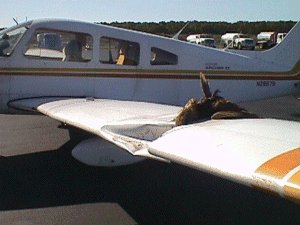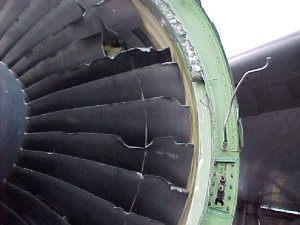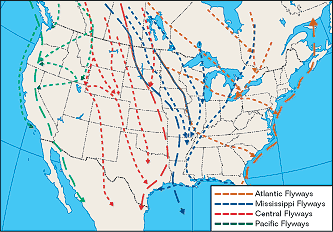Bird and Wildlife Strikes

Table of Contents
Importance to Members
Overview
Technical Information
Additional Resources
From the AOPA Archives
Table of Contents
Importance to Members
Pilots share the sky with birds and bird strikes are a real and not uncommon danger. The majority of them go unreported and result in little or no damage to the aircraft, although for the bird, it’s a different story. A bird strike, sometimes referred to as a bird hit, bird strike, or BASH (Bird Aircraft Strike Hazard), can happen to anyone at almost any time. Reported birdstrikes are on the rise and occasionally make the news. Media coverage of Captain “Sully” Sullenberger’s celebrated landing of US Airways Flight 1549 in the Hudson River in January 2009 captured headlines for many months.
Wildlife strikes also pose a threat to aircraft. In rural and occasionally in urban areas, it is not uncommon for a deer or other animal to wander onto the runway. Pilots must be especially aware, and after taking avoidance action should alert pilots and ground personnel of the hazard. Even though bird and wildlife strikes are for the most part unpredictable and random, there are some precautions that can be taken to lower the odds their occurrence. This subject report develops this idea.
As always, feel free to call AOPA's Pilot Information Center at 800/USA-AOPA (872-2672) with questions.
Overview
The first pilot to ever be involved in a bird strike is believed to have been Orville Wright in 1908. The first recorded fatality resulting from a bird strike dates all the way back to 1912. Cal Rogers, who made history when he flew across the United States, was performing a demonstration flight in California when his Wright Flyer collided with a seagull. The threat of bird strikes became more serious in the 1950s when the aviation industry began using gas turbines for power and the FAA began testing the engines for bird ingestion capabilities. The engines are able to ingest about three small birds (one and one-half pounds) or one medium bird (two and one-half pounds) without failing. The FAA currently considers a large bird to weigh more than four pounds. There is no aircraft engine certified to ingest a large bird without shutting down.
This subject report will inform readers of the risks and preventive procedures surrounding bird and wildlife strikes. Additionally it will discuss how to properly submit a bird or wildlife strike.
Technical Information
 The 112,815 who reported bird and wildlife strikes in the last 20 years may not have seriously considered the damages that could result. Additionally, the actual number of strikes is probably much larger; experts estimate that about 80 percent of them go unreported. If this estimate is accurate, in 20 years there may have been more than 500,000 strikes. Bird and wildlife strikes can be serious and have resulted in more than 350 fatalities. The aviation industry spends nearly $330 million and suffers 500,000 hours of down time each year from strikes.
The 112,815 who reported bird and wildlife strikes in the last 20 years may not have seriously considered the damages that could result. Additionally, the actual number of strikes is probably much larger; experts estimate that about 80 percent of them go unreported. If this estimate is accurate, in 20 years there may have been more than 500,000 strikes. Bird and wildlife strikes can be serious and have resulted in more than 350 fatalities. The aviation industry spends nearly $330 million and suffers 500,000 hours of down time each year from strikes.
The population of birds in the United States has been increasing steadily over the past two decades, including large birds. The Canada goose population has tripled in the last decade, and there are now more than 5 million residing in the United States. These geese weigh an average of 12 pounds. Along with those that live in the United States, there are also between 500 million and 1 billion birds that migrate over the United States each year. This is why more bird strikes occur during the migratory season, which falls between July and November. A majority of bird strikes occur during the day, but about 25 percent occur at night. Birds can often be spotted at altitudes above 20,000 feet, though they usually fly around 7,000 feet above ground level. Bird strikes have even been reported at altitudes as high as 37,000 feet, and birds have been spotted as high as 54,000 feet!
We must also keep in mind the risks of wildlife strikes. According to the FAA’s National Wildlife Strike Database, there have been 898 white-tailed deer strikes in the United States from 1990 to 2010. Deer are more active at night than during the day, and the majority of strikes occur at dusk or at night. Deer are also more active in the Fall. More than half of the total annual strikes occur from September to December.
About 90 percent of bird strikes take place at or near airports, usually during taking off or landing. One of the first things you should do to avoid a bird strike is to avoid areas in which there is a known risk. You can do this by checking notams for bird activity near airports. The FAA Airport/Facility Directory (A/FD) contains warnings regarding bird hazards. If you are not familiar with an airport, be sure to check the A/FD before flying in.
Some other things that you can do to avoid bird strikes are to avoid areas such as marshlands and landfills because birds like to congregate near them. Also, avoid flying beneath a flock of birds. When birds sense danger in the air they have a tendency to dive. If you are approaching a bird you should pitch up. When flying in an area with birds, you should also turn your lights on, as it’s possible, though not likely, the birds may see you in time to move. However, birds on the ground tend to face into the wind. They will probably have their backs toward you as you are taking off. If startled, the flock may take off and fly directly into your path.
It is also important to be familiar with the patterns of migratory birds. As stated earlier, birds migrate between the months of July and November, with the peak being  in September. There are four major migration routes across the United States. These routes are:
in September. There are four major migration routes across the United States. These routes are:
- The Atlantic Flyway, which follows the Atlantic Coast.
- The Mississippi Flyway, which is in and around the Great Lakes and the Mississippi River.
- The Central Flyway, which is situated east of the Rocky Mountains.
- The Pacific Flyway, which follows the West Coast.
If involved in a bird strike, many pilots seem to forget the first and most important rule of flying: Fly the aircraft. There are many accident reports in which a pilot, attempting to avoid a bird, has lost control of the aircraft or even flown it right into the ground. When trying to steer clear of birds, you must remain in control. If you pitch up to avoid a flock, don't pitch up so high that you cause a stall. Here are a few things to keep in mind:
- If you are flying in an area with known bird hazards, make sure that you have an emergency plan in case of a bird strike. Consider each of the phases of flight and know what you would do in each phase. Would you go around? Abort a takeoff? If enroute, could you make it to an airport or would you need to make an emergency landing and, if so, where?
- If the weather is cool, warm the windshield to reduce the chances of it shattering if a bird were to hit. Also consider keeping shatterproof glasses/goggles on hand to wear when taking off or landing in areas with birds.
- If you are involved in a bird strike, regain control of the aircraft before doing anything else. Keep in mind that if the airfoils are damaged, the stall speed may increase and maneuverability may decrease. Most importantly, fly the aircraft.
Remember that deer are naturally camouflaged to blend in with their surroundings. A startled deer hidden in trees near the airport can run at speeds of 20 to 30 mph and could be on the runway before you’ve had time to lift off. And their fixation on lights may keep them frozen if faced with your landing light. For this reason, be prepared to abort a take-off at night, with little notice.
Reporting a Bird or Wildlife Strike
If you encounter birds or wildlife on the airport, you should call the airport management. They have a duty under FAR Part 139 to mitigate wildlife hazards on the airport. You should also report the hazard to air traffic control. ATC has a duty under FAA Order 7110.65, paragraph 2-1-22, to inform other pilots about the hazard, as well as other ATC facilities and automated flight service stations.
If you are involved in a bird or wildlife strike, remember to report it only once you have landed safely on the ground. Be sure to fill out the FAA Bird/Wildlife Strike Report. This form can also be found in the Aeronautical Information Manual (AIM) as Appendix 1 and should be mailed to:
FAA, Office of Airport Safety and Standards
AAS-310
800 Independence Ave. SW
Washington, D.C. 20591
Additionally, you should fill out a NASA ASRS report.
Additional Resources
AOPA Air Safety Institute's Safety Brief on Bird Strikes
Answers for Pilots: Birds in the News
AOPA Pilot, March 2009
From the AOPA Archives
Flying Seasons: Wildlife vs. Airplanes
Polar bears on the airport
AOPA Pilot, October 2007
Never Again: Hawk missile
AOPA Pilot, April 2007